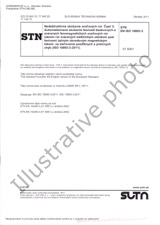We need your consent to use the individual data so that you can see information about your interests, among other things. Click "OK" to give your consent.

STN EN 50065-2-3:2003/OpravaC1 (333435)
Signalling on low-voltage electrical installations in the frequency range 3 kHz to 148,5 kHz -- Part 2-3: Immunity requirements for mains communications equipment and systems operating in the range of frequencies 3 kHz to 95 kHz and intended for use by electricity suppliers and distributors
STANDARD published on 1.12.2003
| Language | |
| Format |
|
| Availability | The sale has ended |
| Price | ONREQUEST excl. VAT |
| ON REQUEST |
The information about the standard:
Designation standards: STN EN 50065-2-3:2003/OpravaC1
Classification mark: 333435
Catalog number: 92628
Note: Correction
Publication date standards: 1.12.2003
SKU: NS-523590
The number of pages: 1
Approximate weight : 3 g (0.01 lbs)
Country: Slovak technical standard
Category: Technical standards STN
This change (correction) applies to this standard:
Signalling on low-voltage electrical installations in the frequency range 3 kHz to 148,5 kHz -- Part 2-3: Immunity requirements for mains communications equipment and systems operating in the range of frequencies 3 kHz to 95 kHz and intended for use by electricity suppliers and distributors
Standard published on 1.9.2003
Selected format:Show all technical information.
We recommend:
Updating of laws
Do you want to be sure about the validity of used regulations?
We offer you a solution so that you could use valid and updated legislative regulations.
Would you like to get more information? Look at this page.



 Cookies
Cookies
